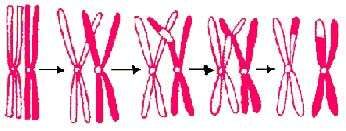|
PinkMonkey Online Study Guide-Biology
(b) Zygotene (Zygonema) : This phase is characterized by the pairing of homologous chromosomes.
The homologous chromosomes (one paternal and the other maternal) from the two sets are attracted towards each other and form pairs. In each pair, the two homologues lie parallel to each other all along their lengths. This pairing is called synapsis (or syndesis or synizesis). During zygotene, chromosomes become shorter, thicker and more distinct.
(c) Pachytene (Pachynema) :
This is the most important stage in meiosis in which
a recombination of characters (genes) takes place through
a phenomenon called crossing over.
The chromosomes become shorter, thicker and more distinct. Each chromosome has two sister chromatids joined by a centromere. Thus, each pair of homologous chromosomes at this stage consists of four chromatids (tetrad) and is called a bivalent. The paternal and maternal chromatids in each homologous pair are non-sister to one another. The non-sister chromatids are twisted round each other in relational coiling and take part in the crossing over.

Figure 6.5 (B) Crossing over
Crossing over : Crossing over is an important genetic phenomenon. It takes place between any two non-sister chromatids of a homologous pair. Crossing over consists of a mutual exchange of equal quantity (segments) of chromosomal material between two non-sister chromatids. It involves the following events: (a) The relationally coiled non-sister chromatids, which are taking part in crossing over, break simultaneously at the identical points (i.e. at homologous points); (b) the broken segments are of equal lengths; (c) the segments again join with the chromatids; (d) however, there may be an exchange of the segments between the non-sister chromatids, i.e. the maternal segment may join with the paternal chromatid and the paternal segment may join with the maternal chromatid. This is called crossing over; (e) In this process, the genes located on the segments are exchanged between the two chromatids. (f) Thus, crossing over results in the recombination of genes (characters); (g) Crossing over does not take place between sister chromatids.
Significance of recombination (crossing over ) : (i) The gametes produced through meiosis receive a new combination of characters (genes). (ii) Therefore individuals with new combination of characters are produced in each generation. (iii) This forms the genetic basis for variations and plays important role in evolution.
|